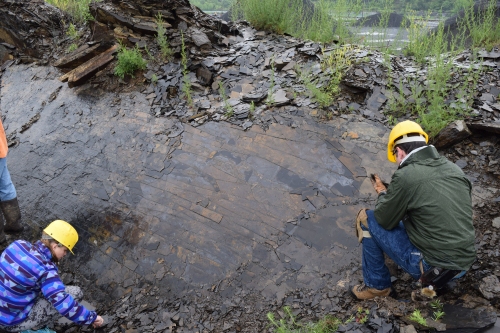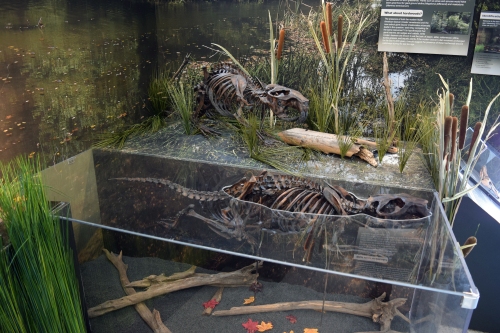Wow, it’s been awhile. The real world has been keeping me busy, but I’ve been researching a couple new museum history stories that I will write up with all haste. In the meantime, I’d like to share some brief thoughts on the Southeast Association of Vertebrate Paleontology conference at the Virginia Museum of Natural History, which I attended earlier this week. SEAVP has a reputation for being fairly laid back, even as gatherings of paleontologists go. No frantic networking or jostling to introduce oneself to celebrity researchers, just a bunch of enthusiastic people excited to share their work.
With 50-some attendees, nearly everyone was either speaking or presenting a poster. Miranda Armour-Chelu took on the challenge of reconstructing the taphonomic circumstances surrounding historically collected dugong fossils. Marcelo Kramer shared his adventures prospecting for Quaternary fossils in unexplored caves in northern Brazil. Julie Rej explained the difficulty of identifying Australian agamid fossils when most modern comparative collections in museums consist of pickled lizards, rather than bones. My own talk was a show-and-tell session of some of the cool new fossils discovered by visitors to Maryland’s Dinosaur Park. If I had to pick a standout session, it would be C.T. Griffin’s fascinating research comparing the growth trajectories of early dinosaurs to modern birds and crocodillians. Not as straightforward as one might expect.
The following day, we visited the famed Solite Fossil Site, one of the most fossiliferous terrestrial Triassic localities in the world. These shales are best known for preserving an abundance of unique insects, but vertebrates and diagnostic plant fossils are also known. In particular, the site has produced hundreds of the tiny long-necked reptile Tanytrachelos. It only took 20 minutes for my colleague Max Bovis to find a “tany”, and an hour later he reportedly found a fossil fish. Both will be entered into the VMNH collection. We also visited Virginia Tech, where Michelle Stocker and Sterling Nesbit provided a tour of the paleobiology department facilities. We saw unique fossils from Ghost Ranch, New Mexico and the extant comparative specimen lab, but I was most envious of their 3-D printing set-up!
What of the exhibits at VMNH? They’re fantastic. Despite the museum’s small size, the production quality on all the displays is really top notch. The Uncovering Virginia hall highlights several fossil sites around the state, including the Ice Age mammals from Saltville, the coal seams of Grundy, and the aforementioned Solite quarry. In addition to original specimens and reconstructions of the excavations, there are a number of inspired hands-on activities. Visitors can put a whale jaw back together and articulate a femur with a pelvis, mirroring challenges actually faced by fossil preparators (nary a sandbox dig in sight!). I also liked a multimedia display where pressing a button (labeled “press here to go back in time”) pulls back an image of the Grundy coal mine and reveals a moving diorama of a Carboniferous coal swamp.
The central Hall of Ancient Life features local whale and Ice Age fossils, as well as some visiting dignitaries like a cast of Big Al the Allosaurus. Don’t forget to check out the second floor balcony, which contains Morrison Formation dinosaur bones and a secret Tenontosaurus mount.
All in all, an excellent conference – hats off to Alex Hatings, Christina Byrd, and everyone else involved in arranging it. I’m looking forward to next year’s meeting, which will be hosted by the Gray Fossil Site Museum in Tennessee!







This looked like a ton of fun. By the way, were there any talks about that new Schwimmer, Sanders, Erickson, and Weems volume about a new Late Cretaceous site in South Carolina. I got the volume a couple weeks back and I figured they might have a talk or something planned.
No word on that, although it sounds interesting – thanks for the tip. I should have included a link to the conference abstracts: http://www.seavp.org/uploads/4/3/4/8/43488561/seavp_202016_20program_20with_20abstracts.pdf
Thanks for the link. I’ll see if I can read some of the abstracts.